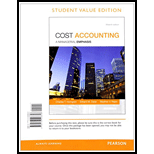
1.
To compute: Manufacturing cycle efficiency
Given information:
Inspection time for 2012 is 4.
Process time for 2012 is 8.
Move time for 2012 is 4.
Order receiving time for 2012 is 15.
Machine setup time for 2012 is 13.
Inspection time for 2013 is 2.
Process time for 2013 is 8.
Move time for 2013 is 4.
Order receiving time for 2013 is 14.
Machine setup time for 2013 is 12.
Calculated values,
Manufacturing time for 2012 is 12.
Manufacturing cycle time for 2012 is 25.
Manufacturing time for 2013 is 10.
Manufacturing cycle time for 2013 is 22.
2.
a.
To compute: Percentage of goods returned
Given information:
Units of finished goods shipped in 2012 are 28,480 units.
Number of units returned in 2012 is 750 units.
Units of finished goods shipped in 2013 are 33,668 units.
Number of units returned in 2013 is 915 units.
b.
To compute: Defective units reworked as a percentage of units shipped.
Given information:
Units of finished goods shipped in 2012 are 28,480 units.
Number of defective units reworked in 2012 is 2,200 units.
Units of finished goods shipped in 2013 are 33,668 units.
Number of defective units reworked in 2013 is 1,640 units.
c.
To compute: Percentage of on-time deliveries.
Given information:
Units of finished goods shipped in 2012 are 28,480 units.
Number of units delivered on time in 2012 is 24,820 units.
Units of finished goods shipped in 2013 are 33,668 units.
Number of units delivered on time in 2013 is 29,935 units
d.
To compute: Percentage of hours spent by each employee in quality training.
Given information:
Average total hours worked per employee in 2012 are 2,000 hours.
Annual hours spent on quality training per employee in 2012 is 38 hours.
Average total hours worked per employee in 2013 are 2,000 hours.
Annual hours spent on quality training per employee in 2013 is 44 hours.
3.
To evaluate: Management’s performance on quality and timeliness.
Want to see the full answer?
Check out a sample textbook solution
Chapter 19 Solutions
Cost Accounting, Student Value Edition Plus MyAccountingLab with Pearson eText -- Access Card Package (15th Edition)

 AccountingAccountingISBN:9781337272094Author:WARREN, Carl S., Reeve, James M., Duchac, Jonathan E.Publisher:Cengage Learning,
AccountingAccountingISBN:9781337272094Author:WARREN, Carl S., Reeve, James M., Duchac, Jonathan E.Publisher:Cengage Learning, Accounting Information SystemsAccountingISBN:9781337619202Author:Hall, James A.Publisher:Cengage Learning,
Accounting Information SystemsAccountingISBN:9781337619202Author:Hall, James A.Publisher:Cengage Learning, Horngren's Cost Accounting: A Managerial Emphasis...AccountingISBN:9780134475585Author:Srikant M. Datar, Madhav V. RajanPublisher:PEARSON
Horngren's Cost Accounting: A Managerial Emphasis...AccountingISBN:9780134475585Author:Srikant M. Datar, Madhav V. RajanPublisher:PEARSON Intermediate AccountingAccountingISBN:9781259722660Author:J. David Spiceland, Mark W. Nelson, Wayne M ThomasPublisher:McGraw-Hill Education
Intermediate AccountingAccountingISBN:9781259722660Author:J. David Spiceland, Mark W. Nelson, Wayne M ThomasPublisher:McGraw-Hill Education Financial and Managerial AccountingAccountingISBN:9781259726705Author:John J Wild, Ken W. Shaw, Barbara Chiappetta Fundamental Accounting PrinciplesPublisher:McGraw-Hill Education
Financial and Managerial AccountingAccountingISBN:9781259726705Author:John J Wild, Ken W. Shaw, Barbara Chiappetta Fundamental Accounting PrinciplesPublisher:McGraw-Hill Education





